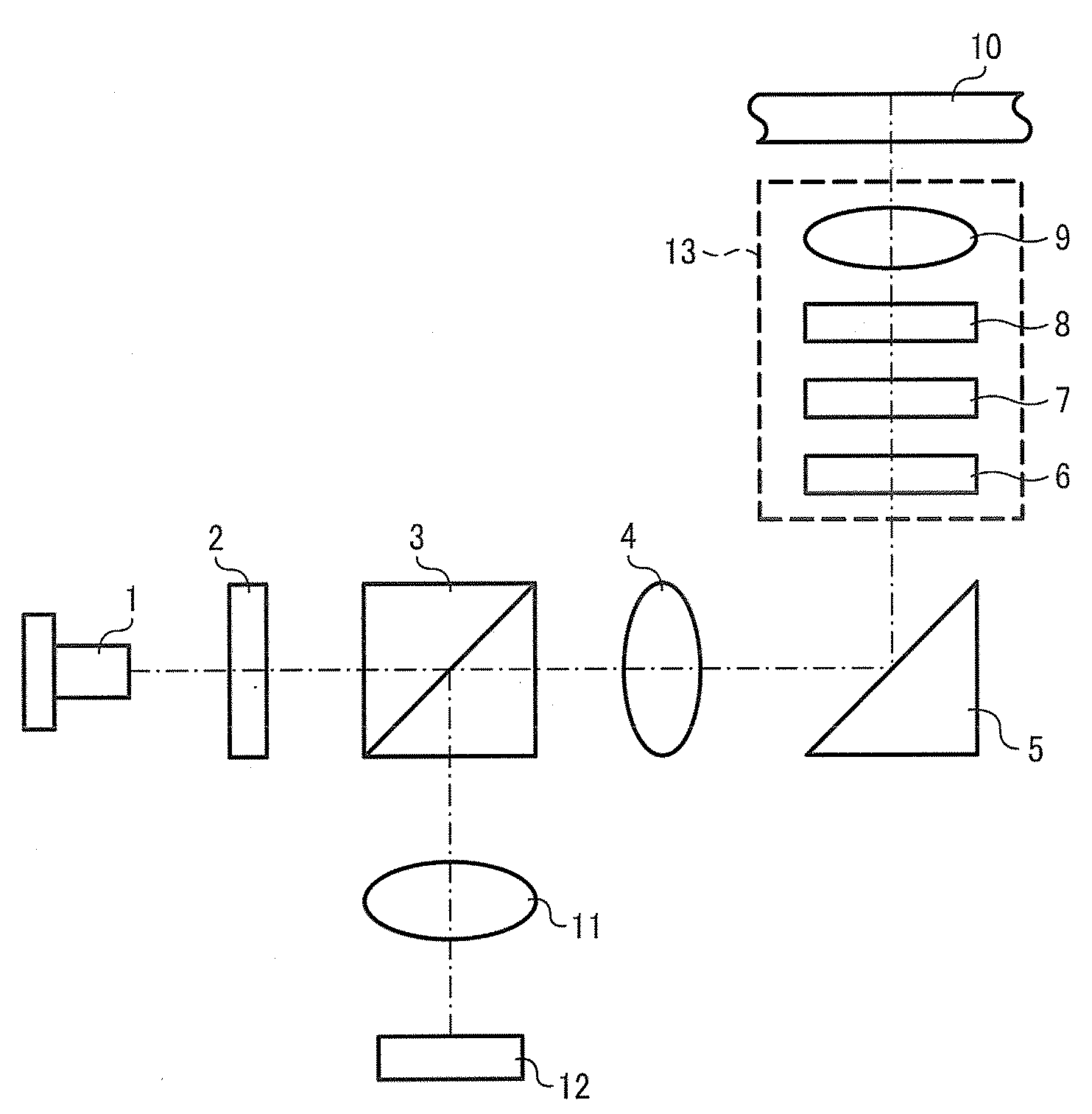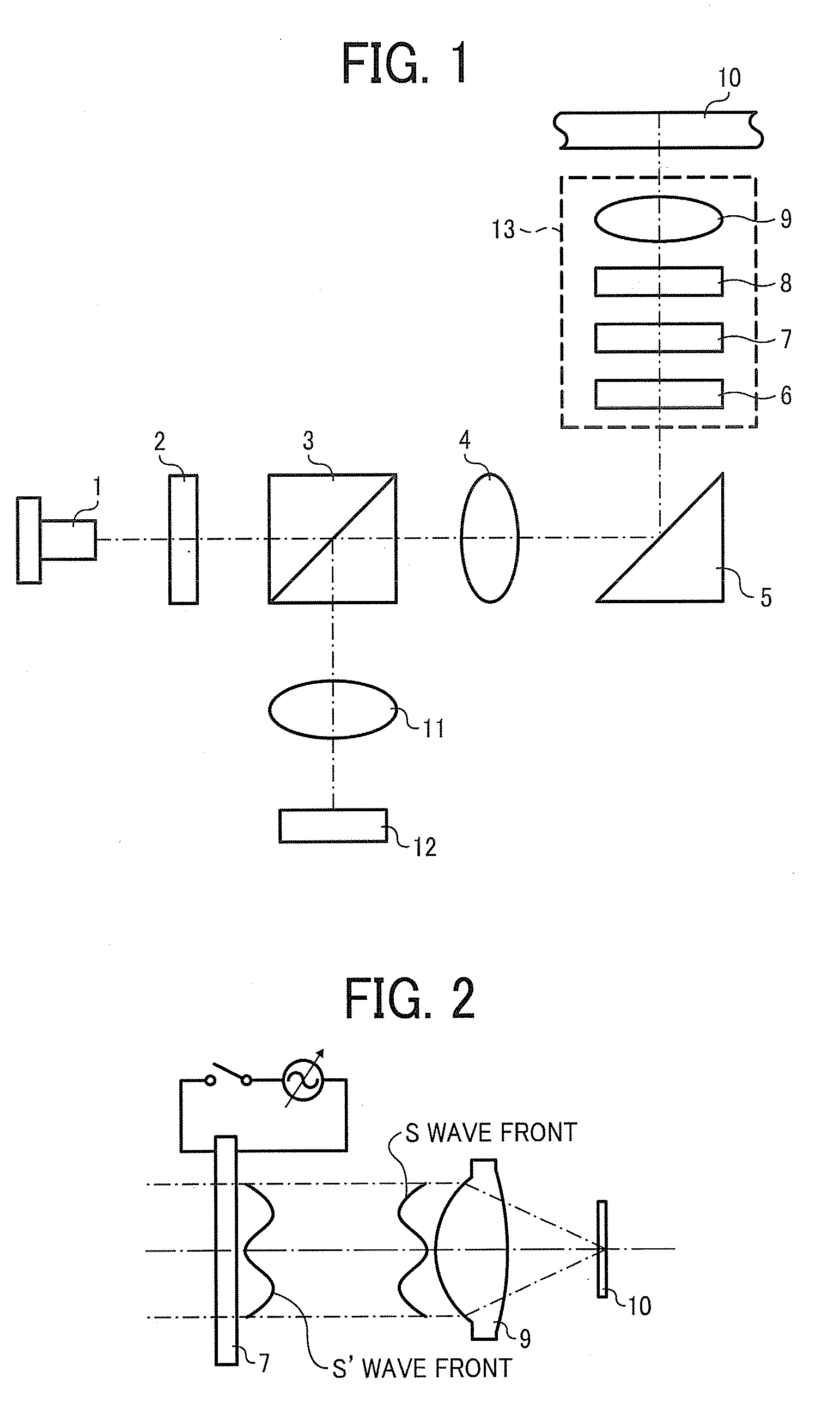Optical pickup and optical data processing device using the same
a technology of optical data processing and optical pickup, applied in the field of optical pickup, can solve the problems of inability to precisely track the servo, inability to accurately track the servo, and inability to output suitably amplified track error signals, so as to prevent the deterioration of track error signals
- Summary
- Abstract
- Description
- Claims
- Application Information
AI Technical Summary
Benefits of technology
Problems solved by technology
Method used
Image
Examples
embodiment 1
[0053]FIG. 1 is a schematic diagram illustrating the pickup of Embodiment 1 of the present invention. In FIG. 1, a numeral reference 1 represents a semiconductor 1, a numeral reference 2 represents a diffraction element for 3 beams, a numeral reference 3 represents a polarization beam splitter, a numeral reference 4 represents a collimate lens, a numeral reference 5 represents a polarization mirror, a numeral reference 6 represent a correction element to reduce cross-talk, a numeral reference 7 represents a crystal liquid element to correct spherical aberration, a numeral reference 8 represents a ¼ wavelength board, a numeral reference 9 represents an objective lens, a numeral reference 10 represents an optical recording medium, a numeral reference 11 represent a detection lens, a numeral reference 12 represents a light reception element, and a numeral reference 13 represent an actuator. The optical recording medium 10 has data recording layers L1 and L2 from the objective lens 9 si...
embodiment 2
[0095]FIG. 6 is a schematic diagram illustrating the optical pickup of Embodiment 2 of the present invention. The difference between the structure of Embodiment 1 and that of Embodiment 2 is that while the optical pickup of Embodiment 1 is exclusive for one optical recording medium (e.g., BD optical recording media), the optical pickup of Embodiment 2 deals with reading and writing data signals on two different kinds of optical recording media, e.g., BD optical recording media and DVD recording media.
[0096]A semiconductor 14 is arranged in Embodiment 2 instead of the semiconductor lased 1 of FIG. 1. Furthermore, each optical element deals with two wavelengths. The semiconductor laser 14 is a two wavelength light source unit which accommodates a light source for BD formed of a laser diode which emits a light beam in the wavelength band of 405 nm and a light source for DVD formed of a laser diode which emits a light beam in the wavelength band of 660 nm. The two wavelength light sourc...
embodiment 3
[0308]FIG. 15 is a block chart illustrating an optical data processing device of Embodiment 3 of the present invention. As illustrated in FIG. 15, the optical data processing device is a device which records and plays data signals for an optical recording medium 10 and includes an optical pickup 41 corresponding to the optical pickups described above; a spindle motor 48 to rotate the optical recording medium 10; a transfer motor 42 to move the optical pickup 41 to and from the inner and outer circle of the optical recording medium 10; a modulation and demodulation circuit 44 to perform predetermined modulation and demodulation; a servo control circuit 43 to servo-control the optical pickup 41; and a system controller 47 to control the entire optical data processing device.
[0309]The servo control circuit 43 controllably drives and rotates the spindle motor 48 at a predetermined rotation number. The optical recording medium 10 to be recorded and played is chucked on the driving axis o...
PUM
 Login to View More
Login to View More Abstract
Description
Claims
Application Information
 Login to View More
Login to View More - R&D
- Intellectual Property
- Life Sciences
- Materials
- Tech Scout
- Unparalleled Data Quality
- Higher Quality Content
- 60% Fewer Hallucinations
Browse by: Latest US Patents, China's latest patents, Technical Efficacy Thesaurus, Application Domain, Technology Topic, Popular Technical Reports.
© 2025 PatSnap. All rights reserved.Legal|Privacy policy|Modern Slavery Act Transparency Statement|Sitemap|About US| Contact US: help@patsnap.com



